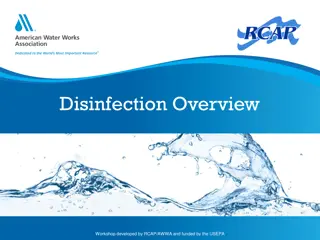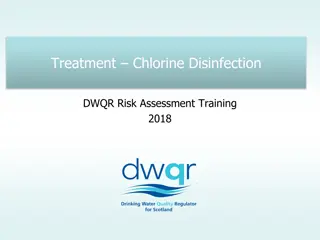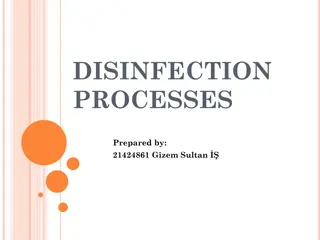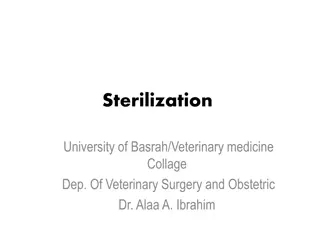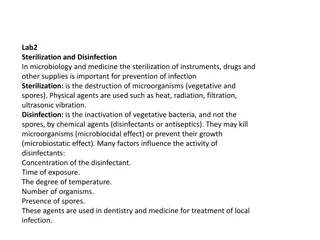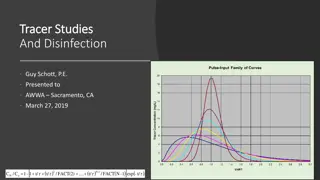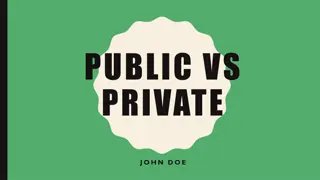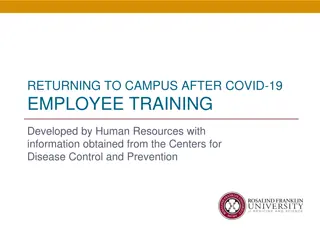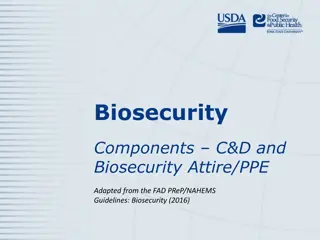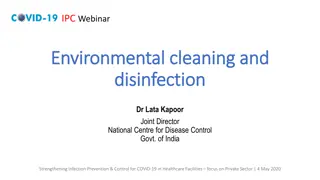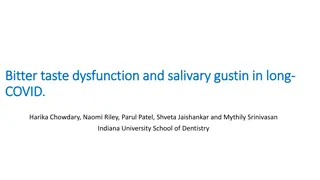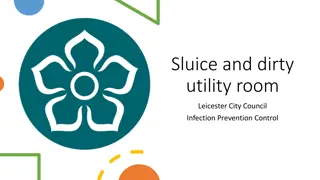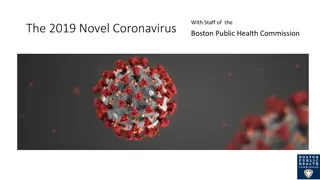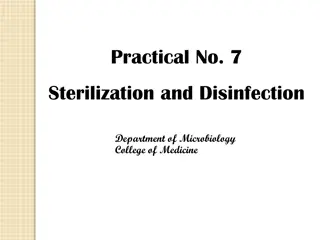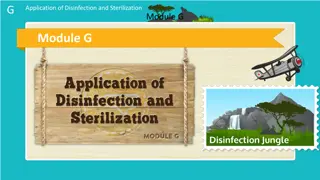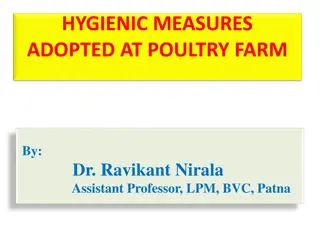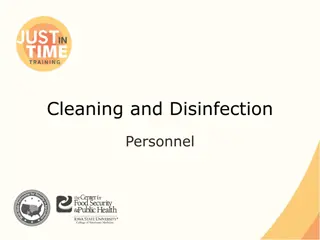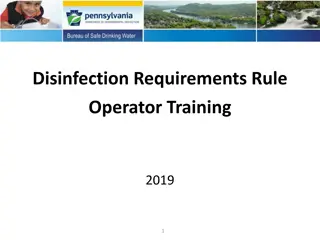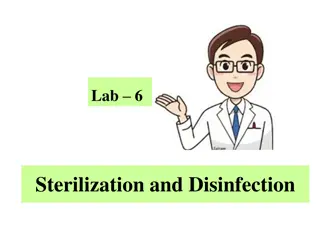Guidelines for COVID-19 Disinfection of Public Places and Offices
Guidelines from the State Institute of Health and Family Welfare in Rajasthan for the environmental cleaning and decontamination of common public places and offices to combat the spread of COVID-19. The guidelines cover areas like indoor spaces, high-contact surfaces, and office premises, detailing specific disinfection procedures and recommended practices to help ensure a safe environment for occupants.
Download Presentation

Please find below an Image/Link to download the presentation.
The content on the website is provided AS IS for your information and personal use only. It may not be sold, licensed, or shared on other websites without obtaining consent from the author. Download presentation by click this link. If you encounter any issues during the download, it is possible that the publisher has removed the file from their server.
E N D
Presentation Transcript
COVID disinfection of common public places including offices COVID- -19: Guidelines on disinfection of common public places including offices 19: Guidelines on State Institute of Health and Family Welfare- Rajasthan 1
Aim Aim To environmental cleaning /decontamination of common public places including offices in areas reporting COVID-1 provide interim guidance about the 2
COVID COVID - -19 19 Corona virus Disease 2019 (COVID -19) is an acute respiratory disease caused by a novel Corona virus (SARS-CoV-2), transmitted in most instances through respiratory droplets, direct contact with cases contaminated surfaces/objects. Though the virus survives on environmental surfaces for varied period of time, it gets easily inactivated by chemical disinfectants. and also through 3
Office Areas Office Areas Indoor areas, Outdoor areas and Public toilets. 4
Indoor areas including office spaces Start cleaning from cleaner areas and proceed towards dirtier areas. All indoor areas such as entrance lobbies, corridors and staircases, escalators, elevators, security guard booths, office rooms, meeting rooms, cafeteria should be mopped with a disinfectant with 1% sodium hypochlorite or phenolic disinfectants. Indoor areas including office spaces 5
High contact surfaces High contact surfaces Elevator buttons, Handrails / handles and Call buttons, Escalator handrails, Public counters, Intercom systems, equipment like telephone, printers/scanners, and other office machines should be cleaned twice daily by mopping with a linen/absorbable cloth soaked in 1% sodium hypochlorite. 6
For metallic surfaces like door handles, security locks, keys etc. 70% alcohol can be used to wipe down surfaces where the use of bleach is not suitable. Hand sanitizing stations should be installed in office premises (especially at the entry) and near high contact surfaces. In a meeting/conference/office room, if someone is coughing, without following respiratory etiquettes or mask, the areas around his/her seat should be vacated and cleaned with 1% sodium hypochlorite. Carefully clean the equipment used in cleaning at the end of the cleaning process. 7
Remove PPE, discard in a disposable PPE in yellow disposable bag and wash hands with soap and water In addition, all employees should consider cleaning the work area in front of them with a disinfecting wipe prior to use and sit one seat further away from others, if possible 8
Outdoor areas Outdoor areas Outdoor areas have less risk then indoor areas due to air currents and exposure to sunlight. These include bus stops, railway platforms, parks, roads, etc. Cleaning and disinfection efforts should be targeted to frequently touched/contaminated surfaces as already detailed above. 9
Public toilets Public toilets Sanitary workers must use separate set of cleaning equipment for toilets (mops, nylon scrubber) and separate set for sink and commode). They should always wear disposable protective gloves while cleaning a toilet. 10
Public toilets Public toilets Areas Agents / Toilet cleaner Procedure Toilet pot/ commode Sodium hypochlorite 1%/ detergent Soap powder / long handle angular brush Inside of toilet pot/commode: Scrub with the recommended agents and the long handle angular brush. Outside: clean with recommended agents; use a scrubber. Lid/ commode Nylon scrubber and soap powder/detergent 1% Sodium Hypochlorite Wet and scrub with soap powder and the nylon scrubber inside and outside. Wipe with 1% Sodium Hypochlorite 11
Public toilets Agents / Toilet cleaner Public toilets Areas Procedure Toilet floor Soap powder /detergent and scrubbing brush/ nylon broom 1% Sodium Hypochlorite Scrub floor with soap powder and the scrubbing brush Wash with water Use sodium hypochlorite1% dilution Sink Soap powder / detergent and nylon scrubber 1% Sodium Hypochlorite Scrub with the nylon scrubber. Wipe with 1% sodium hypochlorite 12
Public toilets Public toilets Areas Agents / Toilet cleaner Procedure Showers area / Taps and fittings Warm water Detergent powder Nylon Scrubber 1% Sodium Hypochlorite/ 70% alcohol Thoroughly scrub the floors/tiles with warm water and detergent Wipe over taps and fittings with a damp cloth and detergent. Care should be taken to clean the underside of taps and fittings. Wipe with 1% sodium hypochlorite/ 70% alcohol Soap dispensers Detergent and water Should be cleaned daily with detergent and water and dried. 13
70% Alcohol can be used to wipe down surfaces where the use of bleach is not suitable, e.g. metal. (Chloroxylenol (4.5-5.5%)/ Benzalkonium Chloride or any other disinfectants found to be effective against coronavirus may be used as per manufacturer s instructions) Always use freshly prepared 1% sodium hypochlorite. Do not use disinfectants spray on potentially highly contaminated areas (such as toilet bowl or surrounding surfaces) as it may create splashes which can further spread the virus. To prevent cross contamination, discard cleaning material made of cloth (mop and wiping cloth) in appropriate bags after cleaning and disinfecting. Wear new pair of gloves and fasten the bag. Disinfect all cleaning equipment after use and before using in other area Disinfect buckets by soaking in bleach solution or rinse in hot water 14
Personal Protective Equipment (PPE): Wear disposable rubber boots, gloves (heavy duty), and a triple layer mask Gloves should be removed and discarded damaged, and a new pair worn. All disposable PPE should be removed and discarded after cleaning activities are completed. Hands should be washed with soap and water immediately after each piece of PPE is removed, following completion of cleaning. Personal Protective Equipment (PPE): 15
Guidelines for Preparation of 1% sodium hypochlorite solution Product Available chlorine Guidelines for Preparation of 1% sodium hypochlorite solution 1percent Sodium hypochlorite liquid bleach 3.5% 1 part bleach to 2.5 parts water Sodium hypochlorite liquid 5% 1 part bleach to 4 parts water NaDCC (sodium dichloroisocyanurate) powder 60% 17 grams to 1 litre water NaDCC (1.5 g/ tablet) tablets 60% 11 tablets to 1 litre water Chloramine powder 25% 80 g to 1 litre water Bleaching powder 70% 7g g to 1 litre water Any other As per manufacturer s Instructions 16
Steps of Hand Hygiene Steps of Hand Hygiene 17
Guidelines for use of mask The correct procedure of wearing triple layer surgical mask Perform hand hygiene Unfold the pleats; make sure that they are facing down. Place over nose, mouth and chin. Fit flexible nose piece over nose bridge. Secure with tie strings (upper string to be tied on top of head above the ears lower string at the back of the neck.) Ensure there are no gaps on either side of the mask, adjust to fit. 18
Guidelines for use of mask Do not let the mask hanging from the neck. . Change the mask after six hours or as soon as they become wet. Disposable masks are never to be reused and should be disposed off. While removing the mask great care must be taken not to touch the potentially infected outer surface of the mask To remove mask first untie the string below and then the string above and handle the mask using the upper strings. Disposal of used masks: Used mask should be considered as potentially infected medical waste. Discard the mask in a closed bin immediately after use. 19
Source- https://www.mohfw.gov.in/pdf/Gui delinesondisinfectionofcommonpubl icplacesincludingoffices.pdf 20
Thank You 21


